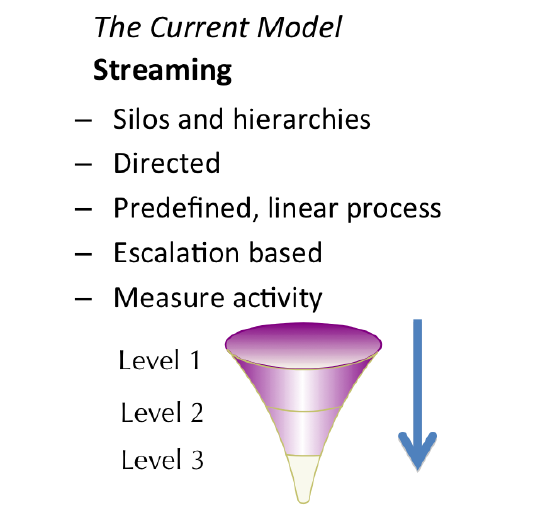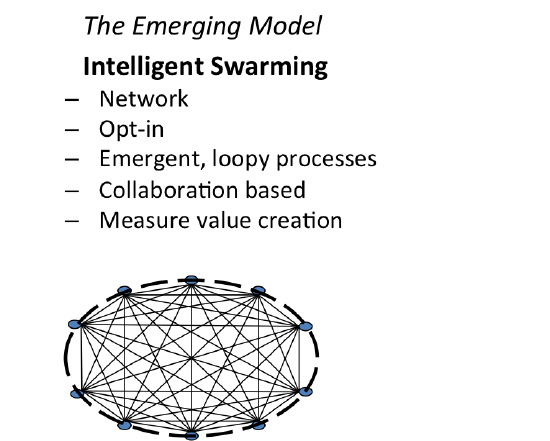What Is Intelligent Swarming?
Rethinking How We Align People With Work
“We have eliminated the word ‘escalation’ from our vocabulary,” says Marco Bill-Peter, VP Global Support Services, Red Hat. Steve Young, formally Service Business Transformation at Cisco, talks about “playing catch, not ping pong,” and a goal of “the first person to work on a customer issue (case or incident) engages the best resources needed to solve the issue and manages it to resolution.”
Intelligent Swarming is a dramatically different way to organize people and work. It challenges 30 years of accepted practice and structure in support. The early adopters of this model are seeing improvements in all key operational measures of support, including time to resolve and employee skills development, as well as employee and customer loyalty.
While not appropriate for all support environments, Intelligent Swarming is most effective when solving new, complex problems. The goal is to get the issue to the best resource (or resources) who can resolve the issue on the first touch. And then, if the person who owns the issue needs help, swarming facilitates finding the best resource to assist. The right people work on new issues, together, as quickly as possible. Collaboration between the right knowledge workers leads to faster and more creative resolutions, as well as rapid skills development. In contrast to the escalation model, where the person who first works the issue never learns the resolution if the issue is escalated, the swarming model proposes the owner of the issue retain ownership until the issue is resolved - even if they need help in resolving it. In this way they will learn the resolution for every issue they work.
What Is Driving This Change?
 There are three drivers behind this change.
There are three drivers behind this change.
1. Organizations are doing a better job of capturing and reusing what they collectively know.
Many organizations have implemented KCS® (Knowledge-Centered Service): a methodology that focuses on creating and maintaining knowledge as a by-product of solving customer issues. Knowledge workers can quickly find answers to questions and problems that have already been solved. Reuse of the knowledge improves the rate at which issues are recognized as known, as well as the speed and accuracy in providing requestors with resolutions. As a result, known issues are resolved faster with fewer escalations. To achieve a corresponding improvement in solving new issues, we need to facilitate collaborative problem solving.
2. Customer self-service is changing the ratio of new to known issues that come into the support center. (Known issues are those that are captured and findable in the knowledge base. New issues require diagnostic activity or research in order to resolve).
KCS creates content in the context of the requestor, so knowledge articles are findable and usable on the web. As use and success with self-service increases, the number of known issues reported to the organization declines, and so shifts the ratio of support requests to new issues.
As knowledge moves closer to requestors via web based self-help, the response processes in the organization must change. In the past, support tiers acted as filters, with each level resolving 70 to 80 percent of the problems it received. The problem had to be pushed or escalated toward the solution. With the web, we are pushing the solutions toward the problem! A number of companies' customers are now solving 80 percent of their issues using the web. This is a great thing, but has two important implications. First, a positive web experience resets customer expectations about time to resolution. Second, when customers contact the support center (for the 20 percent of issues that aren’t solved on the web), the likelihood that problem will require escalation is very high - because it is likely to be a new issue. This has a compound effect. Customers are expecting an immediate response, and the chance that the problem can be solved on first contact is much lower than it used to be. The requests coming into the center are new, unique, complex issues. As a result, customers who can’t find a solution on the web feel like they have to “run the gauntlet” to get their problem solved…every time! As known issues are removed from the support organization’s workflow and the percentage of new issues increases, we need to rethink how we align resources to work.
3. Organizations including support and services are undergoing a shift in focus from internal productivity to customer productivity.
This is a deeper, philosophical transformation happening in customer support. It is characterized by a broader sense of awareness - one that includes the customer and their experience. The Effortless Experience raised awareness to the issue of customer effort, and many companies have put considerable effort into understanding the full customer experience. The enlightened organization is as concerned about the customer’s productivity as they are about their own. We can no longer optimize our productivity at the expense of the customer’s. Swarming improves the customer experience and minimizes their effort.
How Does Intelligent Swarming Work?
Every interaction is an opportunity to improve the next interaction.
Intelligent Swarming is not a new concept to people who work in support and service organizations. They have always collaborated on problem solving, and have done so in spite of the processes, structures, and measures we traditionally use in customer support! What if we facilitated collaboration instead of inhibited it?
Organizations with good self-service models are rethinking their processes and moving from an escalation-based model to a collaboration-based model. They are collapsing their tiers and creating a single team of people who collaborate on solving requestor issues (play catch), replacing the model of multiple teams that toss issues back and forth through incident routing, re-routing, escalation, and rejection (playing ping pong).
 Intelligent Swarming is about getting the people most likely to solve the issue working on the issue as quickly as possible. While we don’t have tiers in a swarming model, we do differentiate between different types of skills. We seek to engage the most appropriate or relevant skill(s) for a customer issue based on what we know about the issue, and what we know about the customer (some are experts, some are novices). At the highest level, we can think about generalists and specialists. Some issues are poorly defined and require lateral thinking skills and an ability to talk to the customer in their context. This is the value of the generalist; they help define the problem when the customer can’t. A good generalist helps define the issue in such a way that we can identify the specialist skill needed. However, if the problem is well defined, we may be able to identify the specialist(s) that would be best able to resolve the issue. The most valuable resource to the organization is a knowledge worker who is both a generalist and a specialist.
Intelligent Swarming is about getting the people most likely to solve the issue working on the issue as quickly as possible. While we don’t have tiers in a swarming model, we do differentiate between different types of skills. We seek to engage the most appropriate or relevant skill(s) for a customer issue based on what we know about the issue, and what we know about the customer (some are experts, some are novices). At the highest level, we can think about generalists and specialists. Some issues are poorly defined and require lateral thinking skills and an ability to talk to the customer in their context. This is the value of the generalist; they help define the problem when the customer can’t. A good generalist helps define the issue in such a way that we can identify the specialist skill needed. However, if the problem is well defined, we may be able to identify the specialist(s) that would be best able to resolve the issue. The most valuable resource to the organization is a knowledge worker who is both a generalist and a specialist.
In a swarming model, the person who takes ownership of the issue often owns the issue until it is resolved. They may engage others in the process of solving the issue, but they don’t lose touch with how the issue is resolved. This is how collaboration enables skill development and, more importantly, this is how we create knowledge workers who are both generalists and specialists! In the existing model, we aren’t giving people the opportunity to develop the range of skills that are most valuable to the organization.
We could think of the old, linear, tiered structure as streaming and the new collaborative model as swarming. Unfortunately, a collaborative process doesn’t align with the way most organizations think about their people or their processes. Over the years, a rigid hierarchy has emerged among tiers, with a strong sense of “them and us,” and arbitrary boundaries that can only be crossed by escalation. The transition from a streaming model to a swarming model is not easy. It is a significant change in that we are taking apart the social hierarchy of service and support. The idea that anyone in support could “earn the right" not to have to talk with customers (a common attitude in higher tiers) is a ridiculous notion. Customer support is, after all, about supporting customers.
Swarming also requires that we give up the highly siloed and compartmentalized structures we have created. Too many organizations have become so enamored with their internal process and service levels between tiers that they have adopted the dysfunctional practice of “rejecting” an incident. Clearly, they are more focused on their niche of the process and their niche measures than on solving the customer’s issue. The only service level that matters is the one with the customer. By contrast, in a swarming model, we don’t reject customer issues. We pursue their resolution with enthusiasm: we choose to help.
There is great variation in the way the early adopters of swarming have implemented the model, but some common themes have emerged. Following are some of the attributes of a successful swarming adoption:
- The organization functions as one team that collaborates on problem-solving (no levels or tiers of support, no escalation)
- The first person to take the request is the person most likely to be able to resolve it (intelligent matching and people profiles)
- The person who takes the request owns it until it is resolved
- People can find the best available person(s) to help (knowledge workers have visibility to people based on skills and availability)
- People can see all the work that is relevant to them (based on their skills and interests)
- People choose to help or opt-in to work that is relevant to them
- Measuring the creation of value (not activity) by individuals and teams
- Managers are facilitators and coaches - not judges and not "owners" of teams
| Traditional Tiered Support Model | Intelligent Swarming Model |
| Silos and hierarchies | Network |
| Directed | Opt-in |
| Pre-defined, linear process | Emergent, loopy processes |
| Escalation based | Collaboration based |
| Measure activity | Measure value creation |
